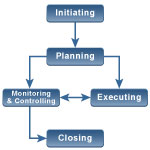
In project management generally - and the A Guide to the Project Management Body of Knowledge (PMBOK® Guide) specifically - best practices dictate a very specific series of process groups that should be performed. These are referred to as Initiating, Planning, Executing, Monitoring and Controlling, and Closing.
The question arises: what problem are we trying to solve by having five discrete process groups? (In the PMBOK® Guide, they are called process groups because each one contains or houses specific processes that should be performed.) The answer is that these processes give us an organizational background to successfully plan, execute, and manage a well-run project. With that said, let's look at each of these process groups in turn and discover why each is so vital to a project's success.

Free Organizational Readiness Course
Learn to Manage Change in a Project Setting with this free course!
Initiating
According to PMI, Initiating helps to set the vision of what is to be accomplished. This is where the project is formally authorized by the sponsor, initial scope defined, and stakeholders identified. Stakeholder identification is crucial here because correct identification (and subsequent management) of stakeholders can literally make or break the project. These processes are performed so that projects and programs are not only sanctioned by a sponsoring entity, but also so that projects are aligned with the strategic objectives of the organization. Where this is not performed, projects may be started and carried out haphazardly, with no real stated goal or objective.
It should also be noted that management chooses and authorizes the project manager here. It's crucial to authorize and establish the PM early as project managers often have accountability but little authority. Strictly speaking, if you don't formally authorize a project, you don't have a project.
Key artifacts created: Project Charter and Stakeholder Register.
Planning
A crucial element of planning is establishing the total scope of the project. While it may appear as though that was accomplished in Initiating, scope (along with risks, milestones, summary and budget) was defined there at a high level. In planning, the project manager uses an iterative and more detailed planning technique, called progressive elaboration, which allows project documents to be developed at a much more detailed level over time.
In the PMBOK® Guide, PMI defines twenty-four discrete processes that are involved in planning. While a project team can decide which of those to choose for a given project, the message is clear: fail to plan, plan to fail. Too many organizations start a project with only a cursory amount of planning assuming that - one supposes - everything will fall into place. But too often, without any real or sufficient planning, chaos prevails.
A significant concept in planning is that the team is able to think the whole project through in advance. So they not only create a variety of plans but also consider all the things that might go wrong (risks) and how they might respond to them. (For the record, the team should also look for unforeseen things that might benefit them - called opportunities - that they can exploit). What types of plans get created? First and foremost, a project management plan, which guides every aspect of the project. This is essential in that it becomes an overriding governance document for the entire project.
Without going into detail on every single document created, a short list would include:
- Documents that bound scope (what we are and are not doing);
- Documents that list detailed requirements;
- Documents that provide estimates for cost and time;
- Documents that provide for a schedule;
- Documents that plan for quality, communications, risk and procurement.
Further we create baselines for scope, schedule and cost against which we can then (in Monitoring and Controlling) track our progress. We also continue to plan for how we will manage and engage the all-important stakeholders throughout the project life cycle.
A cursory glance at the above will reveal the basic nature of what is accomplished during Planning. It creates your roadmap, your path to success. You should no more fail to prepare these plans than an architect would fail to create a blueprint for a building. At the end of this process group, the team should have a very good idea of not only what they're tasked to do - what is in and out of scope - but also what it will take to execute the project on-time and on-budget.
Key documents created: Project Management Plan, schedule, risk register
Executing
The Executing process group is where the work is actually done. The project management plan will help keep us on track. Here is where the project team starts doing the work of creating the deliverables while the project manager coordinates those resources. And if that were the only thing that occurred, that might be enough. But there are several other things that must happen during executing.
Since the project team is so important to successful execution, one must assume that developing the team is important to that cause. So there is an assumption that the project manager will not only acquire and manage the team, but also cultivate it by performing team-building exercises. Likewise, the PM is not only managing communications but also managing the stakeholder engagement, ensuring project and product quality and - if procurement is involved - supporting the effort to contract with a vendor.
It is in this area of Executing that most of the budget will be spent and the deliverables of the project will be produced. And it is likely here where we will begin to see stakeholder change requests. While the project team can implement approved changes, only the change control board can approve or reject these changes.
Project execution could go on for days, weeks, months or years depending on its duration. But it is not enough to execute only. One must make sure the project stays on track. That is where our next process group comes into play.
Key documents created: None. Updates only.
Monitoring and Controlling
The Monitoring and Controlling process group is where the project manager assesses the overall performance of the project and makes necessary changes to keep it on track or to get back on track. What does it encompass? According to PMBOK® Guide, these are "processes required to track, review and regulate the progress and performance of the project; identify any areas in which changes to the plan are required; and initiate the corresponding changes.1" The truth is, you can't assume you'll always stay on plan. In fact, it's likely as not that you won't. Monitoring and Controlling is where you get back on track, where you compare plan to actual, measure variance and take corrective action.
Some examples of areas one might control are scope, cost, and schedule. These all have variations in regards to which tools and techniques you would use to control them. But what each of these have in common is that they have baselines which were defined in planning. Since we're tracking our progress against these baselines, you don't make changes to them lightly. They can be made. But as mentioned, changes will have to be controlled and approved on a case-by-case basis.
One way to think about monitoring and controlling is to imagine that you were driving across the country according to your plan or a roadmap. But if you got lost and you didn't have a GPS you'd stop, ask for directions and get back on track, or maybe based on new information, such as a new road that would cut hours off the trip, you'd change or update your plan.
The lesson learned here is that assuming that you'll somehow magically stay on track just because you've planned to be is a recipe for failure. Only constant vigilance, tracking and reporting will keep the project focused towards meeting its objectives.
Key documents created: None. Updates only.
Closing
From its name, it should be pretty obvious what happens here. Not only do you formally close the project but you also get sign-off and acceptance from the customer. While this should be self-evident, too often projects just fizzle out. People stop coming to the meetings and everyone just shows up at the next one. Best practice dictates that the rigor applied to the rest of the project should be applied here as well. The project manager should formally close the project by archiving records, holding a lessons learned session, and celebrating and releasing the team. And the lessons learned along with other historical information should be centrally archived to be used as input to future projects to prevent reinventing the wheel.
The bottom line is that while these process groups are not necessarily easy to implement, not doing so means the team may never realize the full benefits of their highly strategic projects.
Learn More?
Would you like to learn more about the process groups and best practices of project management? Or the value of PMP certification? If so, Project Management Academy® can help. Call or go online to sign up for the next PMP exam prep boot camp in your area.
Footnotes
1. Project Management Institute, A Guide to the Project Management Body of Knowledge (PMBOK® Guide) - Sixth Edition, Project Management Institute Inc., 2017, Page 23^

 New Horizons
New Horizons
 Project Management Academy
Project Management Academy
 Six Sigma Online
Six Sigma Online
 TCM Security
TCM Security
 TRACOM
TRACOM
 Velopi
Velopi
 Watermark Learning
Watermark Learning
 Login
Login





 New Horizons
New Horizons
 Project Management Academy
Project Management Academy
 Velopi
Velopi
 Six Sigma Online
Six Sigma Online
 TCM Security
TCM Security
 TRACOM
TRACOM
 Watermark Learning
Watermark Learning